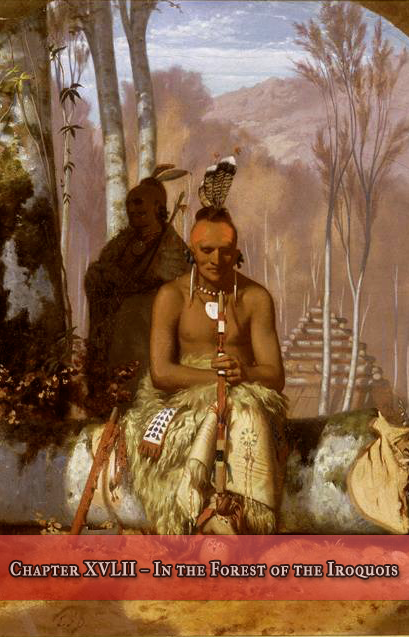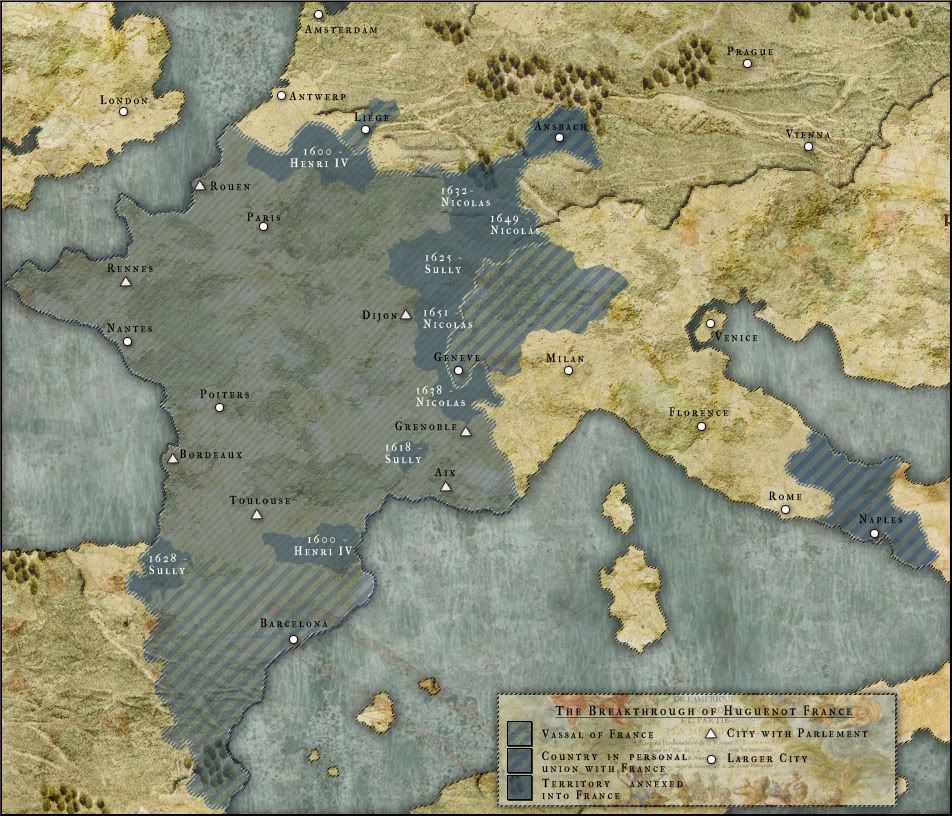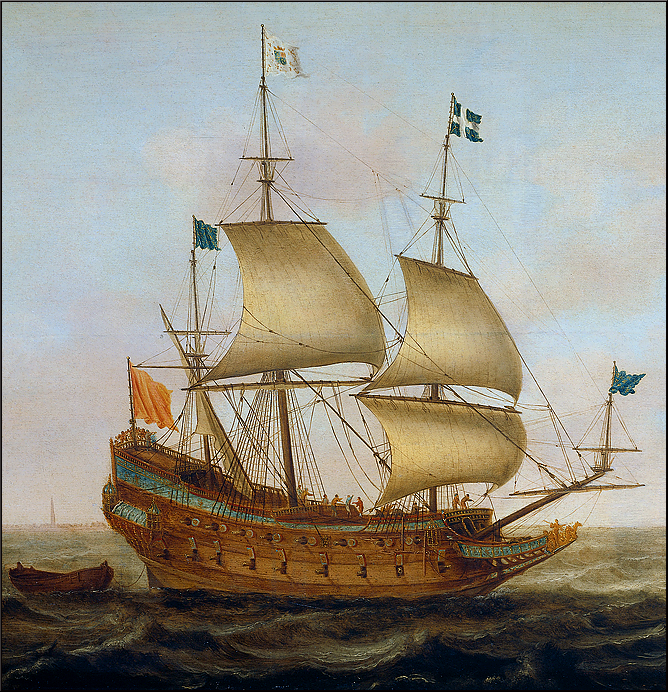Chapter XVLII – In the Forest of the Iroquois
The peace that slowly descended over the ravaged European continent after
the Twin Treaties of 1660 had brought France to what later historians have described as “…the zenith of her territorial and religious borders.” So immense was the power which France had projected over her sphere of influence that now when she was at the height of her power, she had not only won herself a third of “Spain” but had definitely secured the reformation in Europe – at home as well as abroad.
In no period of time following the very first sermons of Luther and Calvin had the Christians who followed the teachings of the great reformers had so powerful protectors or such security in their liberty of religion.
From the uncertain wake of the Wars of Religion to the Army of Flanders’ triumphant entrance into a washed-out Vienna, the first Bourbon monarchs and their interim stewards had enlarged the realm that under the fading House of Valois had been a poor and divided feudal state between the Pyrenees and the Rhine to extend over those “natural borders” and all the way down to the very south of the Iberian peninsular.
Gains had been made as early as 1600 in the former Spaniard Netherlands and in Roussillon where Henri IV had forced terms upon Philip II that also demanded the recognition of the Dutch Republic as an independent state. These conquests marked the northernmost point of Huguenot direct expansion (excluding the vassalage of Liége and the duchy of Ansbach which was united with France in a personal union).
To the south the Huguenots had crossed first the Pyrenees and later the Ebro before all of Catalonia had been consolidated into a new administrative unit within the French kingdom. In the course of 70 years one third of Spain had been torn from the Habsburgs in Iberia – an outstanding feat rivalled only by the later Austrian offensive into the Balkans some years after the passing of the French Crown to the dauphin Louis.
On the border to the Holy Roman Empire both Nicolas and his late stewards had, over some 25 years, aggressively pushed the border of France across the Rhine and into the very core of the Imperial states. By 1662, Nicolas could boast of being represented at the Reichstag in form of his titles as count of Alsace, duke of Baden and count of Ansbach on top of his other roles as king of France, Navarre and Catalonia as well as protector of Liége and the Swiss Confederation.
Map of French expansions 1600-1661. Catalonia is shown as one single unit in union with France and is thus not marked with a date of inclusion, although one could set this to 1660.
However, both the political and religious expansionism led so aggressively by the Louvre didn’t only reunite France with provinces on which she had claims – on the contrary many areas which the Bourbons incorporated into their new absolute state possessed substantial amounts of inhabitants of whom it can easily be said that “…they were not exactly thrilled to see the arrival of the fleur-de-lis and Huguenot cross at the bastions of their old institutions.”
Dissenters did not have bright futures within the frames of an absolute and centralized monarchy, such as that of France, and since the many wars produced a great number of unsatisfied people of both French and “foreign” heritage as well as Calvinist and Catholic convictions, something had to be done – lest France face internal turmoil like that of the Wars of Religion.
Relatively small amounts of die-hard supporters of the
Ligue Catholique had already left the country for Spain when it became evident that the King of Navarre was going to keep on sitting comfortably on the French throne, but they had been further disheartened at the lack of success which their émigré armies attained during the turmoil of the Great Wars of Religion.
Faced with being watched with increasing amounts of suspicion from the Olivares government and the slow bust steady acceptance of Calvinist rule by the remaining Catholic populace in France (Catholics was said to constitute around 40% of the French populace in the 1640ies) the French émigrés in Spain returned home to the remaining Catholic safe havens around Paris. But despite a new generation of Catholic Frenchmen having grown up under the protective wings of the Edict of Nantes (1600) and with many of those serving the royal government faithfully, there still remained a clique of Leaguers and their descendants who were unable to fully accept the Protestant dominance of the French monarchy.
For these people only one option remained… and that was the perilous and month-long route from Western France, across the great ocean and to the shores of the New World.
Painting of a French naval vessel. Such ships mostly served in the royal navy, but many older crafts were used to transport settlers to the new provinces.
Where the River Narrows
***
French sailors and cartographers had already explored the coasts of what was to become modern day Canada when a group of adventures petitioned King Henri IV for permission and funding for a more planned mission to the mouth of the St. Lawrence River. Wanting his piece of the colonial cake, but not willing to commit too many resources in a time where the French state still lingered in a dangerous position squeezed in between the two great Habsburg houses, Henri gave his consent alongside a small commission to the leaders of the expedition.
The expedition didn’t result in overwhelming positive results, but a foothold was established at the mouth of the St. Lawrence as well as on the eastern shores of Newfoundland.
Whilst the native tribes could have easily have expelled the small amount of settlers that arrived in the new French colonies, they chose not to. This eventually resulted in many deaths amongst the tribes given the great amount of diseases which the French carried with them, but the Indians were incredibly vulnerable to.
Thanks to the arrival of new groups, the first Catholic enclaves were reinforced with Catalans, Basques, French and Germans from all kinds of different branches of the Christian three who sought a new life in the shadow of the great American forests where they could work and pray as they wished. The emigration of so many non-Huguenots as well as Protestants who differed slightly from the ruling doctrine (mostly because of their opposition to absolutism) proves that the Edict of Nantes had not been working properly in Bourbon France, despite the government’s attempts at healing the religious wounds.
From their bases on Newfoundland and Acadia new groups of adventures ventured down the foaming currents of the St. Lawrence always under the watchful eyes of the local braves who supplied and helped the French through the trade of furs, supplies and gunpowder. Most famous of these captains was Samuel de Champlain who in 1614, in the company of some two hundred former Leaguers and Reformers divided on three ships arrived at a small point where the Great River narrowed. The area was immediately commended for its excellent position as a strategic point for strengthening further French control over the fur trade and soon thereafter a stockade and moat was created to protect the new and prosperous settlement that grew from Champlain’s caring organisation. Taking the native Algonquin name for the area, the French baptized the fort
Kébec which literally means “Where the River Narrows”. From there more expeditions ventured down to the Great Lakes further east and south – eventually paying visit to the nations of the Hurons and the confederations hidden deep within the forests of the Iroquois.
After the first waves of largely French Catholic settlers had created small communities either side by side with the local native tribes or alone and isolated on the windy coasts, the relatively peaceful life in the new world was shattered by the demands from Metropolitan France that the new colonies were to partake in the conflict between the homeland and the Catholic powers.
The Portuguese colonies further south had all been overtaken by the British militias who streamed out from Boston in a desperate attempt at isolating their Dutch partners/rivals in New Amsterdam, however, Austrian, Czech and German settlers had all set sail from the Imperial port in Danzig and laid claim to some territories and trading posts north of Acadia and Newfoundland. It would be these, far vaster, territories which the colonial government in Acadia set their eyes on.
With the aid from three squadrons of larger ships, the French colonial militias and their native allies made such progress that by the 1640ies no other great power but France had any significant presence on the eastern coast of the northernmost part of the American continent. The Habsburg settlers were mostly the direct contradiction of their early French counterparts in the sense that they were forced to flee their native homes out of fear of persecution and, more often than not, death. Thus with the gradual integration of the non-French settlements the area known by most Europeans as Canada (from the Iroquois word
Kanata, which means settlement) the French dominions in North America were inhabited by a, previously unheard of, mixture of different nations (both native and European) who all confessed to just as many differing religious creeds.
Many people see this intermingling as a foreboding of the multicultural entity Canada would rapidly evolve into following the incorporation of the British posts in the Hudson Bay, but one must remember that these settlements were scattered all over the French domains and that the Catholic and Reformed towns and villages seldom had much to do with each other besides the minimal inter-colonial trade that blossomed side by side with the extensive fur-trade aimed at the Old World.
It’s interesting to note that even though the settlements managed to “peacefully coexist”, as one historian described the rag-rug that was French Canada, each and every one seemed to posses a form of individual idea of Manifest Destiny so wildly seen in the British colonies.
Colonial France in the late 1660ies shown with the most important settlements and trade routes.


No idea who the false Palatine really is, though.






Also, I suppose I'd best ask permission to do a Catholic quiz.

